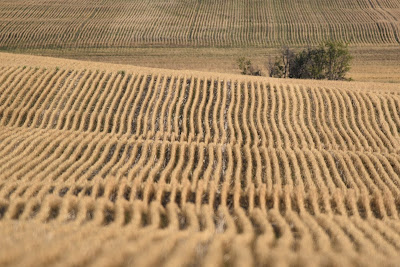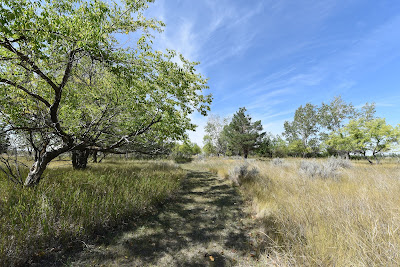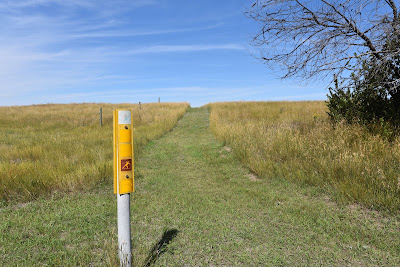Summer Sunsets : Elbow to Danielson Provincial Park
This morning began with one of those incredible prairie sunrises, when the sky turns rosy pink and gold as the red disk of the rises above the horizon. Before leaving the quiet Village of Elbow we took one last walk down its wide main street. Along the way we stopped to examine the sod house, which is part of the Elbow and District Museum. In the early 1900's wood was so scarce on the prairies that settlers often built their first homesteads out of sod. It was fascinating to see how the exterior, which was constructed from rectangular bricks of earth, contrasted with the period furnishings of polished wood, the lace, fine tablecloths, and porcelain dishes inside.
At the edge of town we stopped for Sean to photograph the well-preserved white and red grain elevator, which was lit up by the morning sun. As with many of the historic wooden grain elevators we've passed in Manitoba and Saskatchewan, the roof was covered in Rock Doves. Their soft cooing always seems to give these elevators their own voice, much like the cathedrals in Europe, which periodically speak to the surrounding towns and villages through the ringing of their bells.
As we made our way out of town, walking towards the bright blue waters of Lake Diefenbaker, we passed the edge of a small valley that was filled with small shrubs and grasses and we were delighted to spot two grazing Mule Deer!
We made our way among rolling fields of golden grain, the hot sun at our backs, a bright blue sky with wispy white clouds overhead, and the royal blue waters of the lake beside us. The fields of grain seemed to stretch to the horizon, giving us what we've come to think of as the quintessential prairie experience.
Throughout the morning we boxed north, then west to the lake, then north, then back towards the lakeshore again. Small sparrows flitted among the grain stalks in the fields, and we spotted a Sprague's Pipit running down the edge of the gravel road. Overhead a Northern Harrier soared in the clear blue sky, searching for morsels in the field below.
About 14 km into our hike we approached the lakeshore community of Sunset Beach. The road dipped down into a sheltered inlet at the base of a flooded coulee, the grassy hills rising up on either side. Above us was a small community of summer homes and RVs, perched high up, right in the edge of the reservoir. As we skirted the inlet and then continued back inland we passed another part of the planned community, which was still developing. It consisted mostly of gravel lots separated by wooden fences with several rows of RVs parked in each bay.
As we've hiked across the prairies we've seen many campgrounds, parks, and communities that consist of RVs or small homes sitting in the midst of wide open fields. Seeing these developments during a heat wave, in the midst of a baking hot day, it has taken me a long time to appreciate why anyone would choose to relax or live in such an exposed spot. However, I've come to understand that the beauty of the harsh and exposed prairie landscape is often hardest to see in the midday sun. It is there at sunrise and sunset. It is there in the nighttime skies that are so full of stars the eyes and mind can't fully grasp the vastness. It is there in the stillness and quiet of foggy days, when the hundreds of subtle shades of greens, yellows, browns, and reds come forward, and at any moment an elk, deer, or bear could emerge from the mist. It's there when the fields of grass and grain move like waves, giving us a brief glimpse of the wind. I'm certain it is there in the northern lights, and in a hundred other moments I've never seen or imagined. Although my soul is undeniably tied to the lush shady forests and lakes of the Great Lakes St. Lawrence and Boreal landscapes, this hike has led me to appreciate the pull of places like Sunset Beach.
As we continued towards the border of Danielson Provincial Park on gravel roads, dirt roads, and grassy tracks the trail was generally well marked, and in quite a few spots the trail markers even gave the distance to the next turn. In a few spots the markers were missing however, meaning we nearly passed a turn because we were complacently waiting for the next sign.
By mid afternoon we came to the final stretch, where we walked passed an enormous combine that was harvesting straw. The dust from this operation was stunning, and seemed to travel a long way across the fields. We found ourselves covered in yellow grit and coughing. We never appreciated how dusty harvest time could be! By the end of two concessions we were both covered in a fine yellow dust and sneezing constantly!
As we continued through the hot afternoon sun we passed many interesting old wooden barns and outbuildings. We could see the blue waters of the lake right through a few of them, and in others the sunlight filtered between the boards to create interesting shafts of light.
When we reached the boundary of Danielson Provincial Park we were in for a treat, although it wasn't what we'd expected. From about 5 km back we could see what looked like a wall of trees, so we were expecting a forested trail. Instead, we found ourselves in a stunningly beautiful native prairie habitat. Warm golden and light brown grasses swayed in the slight breeze, broken by the silvery leaves of wolf willow shrubs, the soft bluish green of the strongly scented prairie sage, and partially shaded by shrubs, trembling aspen, and other small scattered trees. The song of the crickets was loud, mixed with the rustling of the aspen leaves.
The flat grassy trail led us through open grasslands, and through tunnels of thorny shrubs with beautiful clusters of bright red berries. As we approached the campground we found ourselves weaving through soft, rolling hills. The natural crevices were filled with trees, their leaves beginning to turn yellow and coppery brown, complimenting the reds and burgundies of the shrubs below them, and the purples and yellows of the wildflowers that dotted the fields.
After crossing a very challenging looking Frisbee golf course we came to the main entrance to Danielson Provincial Park. The park gate was closed but happily the store was open and selling deliciously cold ice cream! We sat on a wooden bench to enjoy the cool treat before booking a campsite online and heading over to the campground.
We found our nice treed site and set up, washed our clothes in our little bucket and hung them up in the scorching hot sun to dry, and then had showers. Just behind our site was a natural area with tall grasses and conifers. There was a family of Merlins flying among the trees, the young begging and whining for food at high volume, which was quite entertaining to watch. One of the adults was banded too, which was kind of exciting! If every day's hike could end this way life on the trail would be truly lovely.
Danielson Provincial Park was named after Gustaf Herman Danielson, a Swedish man who immigrated to Canada from Minnesota in 1904. He was the foreman of the Wells Land and Cattle Company. He started his own farm, planting a grove of trees, which was unusual at the time. In 1922 he was elected a councillor, and later a reeve of the RM of Arm River, a school trustee, and then director of the hospital board. From 1934 to 1964 he served as the member from Arm River in the Legislative Assembly of Saskatchewan. His biography is a humbling reminder of how much of a difference one person can make.
The park opened in 1971 and features treed campsites, several sandy beaches, multiple boat launches, great fishing opportunities in Lake Diefenbaker, and hiking trails that wind through a variety of habitats, including grassland, sand dunes, and treed areas. It spans both sides of the Gardiner Dam, and also offers a Visitor's Centre with interpretive displays for the hydroelectric power in the northeastern portion if the park.
Across the waters we could see the long straight line of the Gardiner Dam, with the five tall penstock control towers rising above it. The Gardiner Dam is the third largest embankment dam in Canada and one of the largest in the world. It is 64 m (204 ft) tall, nearly 5 km (3.1 miles) long, 1.5 km (0.93 miles) wide at its base, and has a volume of 65,000,000 cubic meters. Highway 44 crosses the top of it. When it was built in the 1960's it dammed the south Saskatchewan River, creating Lake Diefenbaker.
The dam is owned and operated by the Saskatchewan Water Security Agency. An integrated power generating plant, SaskPower's Coteau Creek Hydroelectric Station is located at the dam and produces a net 186 MW of electricity from three generators. This accounts for about 5% of Saskatchewan's annual power consumption.
As darkness fell we made our way back up to the tent, stopping to watch a Common Nighthawk foraging for insects above us, it white wing patches clearly visible. Tomorrow we will spend the day exploring the park, walking the rest of the Trans Canada Trail to where the 120 km water route picks up, and deciding how to make our way around the water trail to Saskatoon. As we lay here we can hear the call and answer of two owls in the treed campground, and the calls of another bird we cannot identify. This gentle night chorus was joined by the songs of at least two groups of coyotes, and the soft footsteps of something walking in the grass behind the tent.
As I reflect on the past few days I would have to recommend that anyone who wants to experience what it's like to walk across Saskatchewan on the Trans Canada Trail should begin in Eyebrow or Douglas Provincial Park and walk to Danielson Provincial Park. The trail in this section is a mix of gravel roads, dirt roads, grassy tracks, and gorgeous trails, giving you the full spectrum. It takes you through seemingly endless fields of golden grain, into two beautiful provincial parks with patches of native prairie, to the lovely and bustling resort town of Elbow, and along the shores of Lake Diefenbaker. If you begin in Eyebrow you will also experience the charm and friendliness of a typical small, quiet prairie town.
The past few days have been a pleasure to hike, and seem to have given us a full range of experiences that we have greatly enjoyed!
See you on the trail!
Remember to follow our entire adventure here : www.comewalkwithus.online





















































Comments
Post a Comment